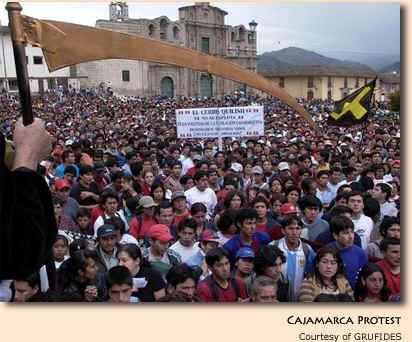 TigerSoft News
Service 2/14/2008 www.tigersoft.com
TigerSoft News
Service 2/14/2008 www.tigersoft.com See 2/4/2008 NEM technical study. revised 3/4/2008 -
Indonesia will terminate NEM's copper mine.
More on recent Insider Selling at Newmont.
THE ENVIRONMENTAL COSTS OF GOLD MINING ARE VERY HIGH.
Buy and Hold Is Dangerous: See All The Peerless Real-Time Signals: 1981-2008
====================================================================================
Newmont's Gold Mining Brings Protests All over the World:
Widespread Environmental Degradation and Health Hazards
by William Schmidt, Ph.D. (Columbia University)
From Indonesia to Peru to Turkey, to Nevada. Newmont Mining (NEM) is
accused of contaminating land and water with arsenic, mercury and other heavy metals,
causing severe health problems, killing local fish, bribing local governments and destroying
the local ecosystem and the longer term viability of local communities. There are many,
many articles on the internet, each repeating the same story: Newmont claims it cares
about the environment and local people, but everywhere it covers up the severe environmental
pollution and health problems its mining creates. Numerous lawsuits, internal company
documents, regulatory filings show this. Investors in gold and silver stocks should see the real
costs of mining and demand their companies behave responsibly, openly and humanely. It's
getting to the point where one cannot do an internet search on Newmont without seeing the outcries
its activities provoke. Clearly that works to depress its shares. But they can go down more, if its
leases are withdrawn and their mines expropriated. Already, its mines in Uzbekistan have been nationalized,
in part because that country's officials could readily claim that Newmont's operations were not operating
at safety and environmental standards like those in the US. Now Indonesia is threatening to
cancel its lease operations. If Peru follows Indonesia's lead, NEM's stock will be in big trouble. In
2006, Peru nationalized natural gas production. In 1973, Peru nationalized most of Cerro de Pasco
Corporation's mining properties along with those of other foreign mining companies. The mines were
then privatized in 1990.
 Though the candidate seeking
to nationalize the mines
Though the candidate seeking
to nationalize the mineswas defeated in Peru's 2006 election, investors should see the risks. Ollanta Humala won
45% of the vote. He won 14 of Peru's 24 departments (administrative regions) and swept his
stronghold in the southern highlands, where the country's poor and indigenous population is
concentrated, receiving 80 percent of the votes there. Peru's new President now sees a broad
chasm representing Peru's social divide. "it is a distinct possibility that he will try to fall back
on the populism of his first presidential term, perhaps in order to fend off direct action by
Humala's forces." The shadow of Venezuela's Chavez is ever present. Nationalism and
nationalizations are on the rise.
(Source: http://www.pinr.com/report.php?ac=view_report&report_id=506&language_id=1 )
Newmont is the world's top gold producer.industry. It employs 15,000 people around the world.
It had revenues of $5.6 billion and produced more than 300 tons of gold last year. With gold prices at
record highs, one might expect Newmont to be trading near or at its all-time high. It is not. It is 12
points, or 20%, below its high of 1996. Its costs are rising steeply. Each ounce of gold cost NEM $406 in
2007 compared to $303 in 2006. Capital (direct mining costs) expenditures were $100 million to $300 million
below what was predicted by the company. On February 15, a day after this Blog was written, Moody's
cut Newmont's ratings.
"Moody's Investors Service on Friday cut its investment grade senior unsecured ratings for
Newmont Mining Corp. to "Baa2" from "Baa1" and of its subsidiary, Newmont USA, to "Baa3"
from "Baa2," citing a jump in their operating costs. The action affects about $1.1 billion of
NEM debt. Moody's said the downgrade also reflects uncertainty about the costs at the
company's Phoenix (Nevada) mine and the need to accomplish major objectives at some of its large
operations to improve its overall cost position."
2/15/2008: http://biz.yahoo.com/ap/080215/newmont_mining_credit_rating.html?.v=1
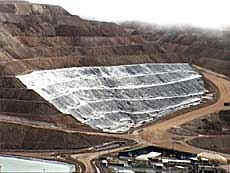
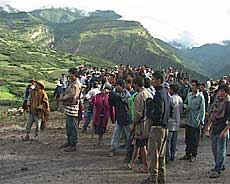
The Yanacocha gold mine in Peru piles up ore and drips cyanide through its vast hillside:
Critics say the government granted the concession only after accepting bribes from Newmont,
and without consulting local communities, which are now suffering because the area has many
farms that rely on water coming from the mountains in the mine area. Source. See also.
What is causing non-direct mining costs to rise so sharply? Executive Pay is high. Richard
O'Brien, the company's CEO total compensation was $3.56 million in 2007, up $1.52 million the year
before, despite the sub-par performance of his company's stock, compared to other Gold stocks or
Gold. Higher still is the "hidden payroll", which includes very high Legal expenses and PR campaigns
to ward off the dozens of law suits and government claims against NEM. In Indonesia, the company has
spent a $1 million a month on legal expenses alone. So is Bribery.in Indonesia, Turkey and Peru. All the
while, proven and probable gold reserves are down from 93.9 million ounces in 2006 to 86.5 million ounces
in 2007. ( Source: http://biz.yahoo.com/bizj/080207/1588572.html?.v=1 ) And add in Spying on
Environmental Opponents. ( Source: http://www.corpwatch.org/article.php?id=12985 ) (NEM is
one of many multinational corporations, like Monsanto and Freeport, which have large hidden payrolls and
increasingly expensive Environmental Insurance. Then there are the Work Stoppages
and Road-Blocking Mass Protests. NEM had to shut down its vast Yanacocha gold mine in
northern Peru because 200 protested blocked the main road to the site. It is the largest gold mine in Latin
America.
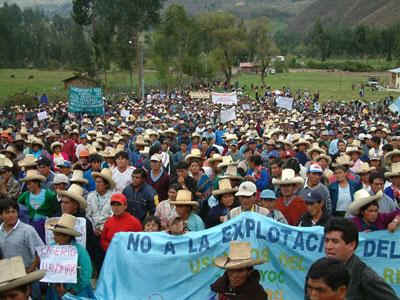
Yanacocha is the world's second-largest gold mine. It produced 1.55 million ounces in the first six months
of 2006. With gold at $900/ounce, that's $135 Billion dollars worth of gold. NEM cannot afford to
lose this mine. (See http://www.denverpost.com/business/ci_4253289 )
WHY IS NEWMONT NOT ADVANCING WITH THE PRICE OF GOLD?
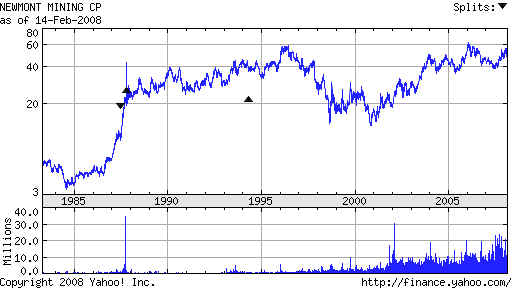
Professional investment managers are concerned that NEM has not set aside
sufficient funds to cover the
growing legal liabilities its mining operations pose. Year after year, Newmont
has had to pay millions to its lawyers to fight off environmental degradation lawsuits in
Indonesia and Peru..
Community protests in Peru nearly forced the
closing of the company's most profitable mine, Yanacocha, in
September 2004. NEM is accused of intimidating its critics. It filed a
"defamation lawsuit against an Indonesian
professor, Dr. Rignolda Djamaluddin, who spoke publicly about Newmont's practice of
dumping mine waste
in Buyat Bay. "I am here because Dr. Rignolda cannot be here as a result of this
lawsuit that is meant to
intimidate us and stifle our voice," said Nur Hidayati of Indonesian Forum for the
Environment (WALHI).
"Our communities demand Newmont end its practice of dumping mine wastes into the
ocean. This irresponsible
practice poses high risks to the environment and the community -- and it is not allowed in
the United States
where Newmont is based." *Source: http://www.nodirtygold.org/newmont_agm.cfm
)
INSIDER SELLING IN NEM
The stock of Newmont now shows steady red Distribution on the TigerSoft chart below.
When the Tiger Accumulation indicator drops below -.25, we label that significant insider
selling, in the
sense that someone on the inside has probably passed along bearish information which is
causing
unusually heavy and persistent daily selling on intra-day strength. Back in the
Summer of 2006, such
steady Red selling pressure from our indicator correctly foretold the stock would go down
on news
which had not yet been released. The news that was belatedly released, after the
stock has already
dropped 20%, was the nationalization of NEM's gold mines in Uzbekistan. The story of
this insider
trading in NEM and a chart showing the heavy RED selling pressure BEFORE the stock fell
20%
is seen at the bottom of page on this link: http://www.tigersoft.com/--5--/index.html
We don't know
what the bearish news is that the present insider selling shows, but we can expect it
after the stock
has already seen a significant drop. The public is
often the last to know something important with
this stock. That's why you should
TigerSoft! As it turns out, insiders of record are selling NEM.
Wayne W Murdy, NEM's CEO, sold 125,000
shares between 50.29 and 50.5 on December 6, 2007.
Murdy sold 52,000
more on December 17th, 2007. Murdy says NEM is
committed to being a
good steward and
protecting the environment.. The reader can judge if this is just more
"PR".
2/4/2008 NEM technical
study
International delegations have protested the hardships faced by hundreds of farmers in
Rosia
Montana, Romania and in the Ahafo region of Ghana. They were being displaced from their
homes
to make way
for large, industrial gold mines owned by Newmont and its partners.
Villagers in Ghana
claim that
Newmont has contaminated local water supplies Bribing local officials to let them
proceed
is a
recurrent accusation. "I have come from Romania to tell Newmont that the
people of Rosia Montana
will not be
forced from our homes and our land," stated Stephanie Roth of Alburnus Maior, a
community
group of farmers
and property owners in Rosia Montana. "Newmont has not obtained the
community's
consent to
operate in Rosia Montana. It's time for them to cut their losses and leave the
project." "We have
been trying to
engage with Newmont for several years and have yet to see real change in
their practices," said
Father Marco
Arana of Grufides, an environmental and social justice organization based in Cajamarca, Peru.
"It took
30,000 people protesting in the streets of Cajamarca for them to finally recognize there
were serious
problems."
In Turkey,
"production has been off and on at the Ovacik gold mine near Bergama in
western Turkey
for more than a decade amid environmental protests and legal challenges from local
people over the
use of a cyanide-leaching method for extracting gold. Newmont draws outcry in Asia
Mine in Greece to shut
down. As a new high court
decision in Greece puts an end to mining
underneath the village
of Stratoniki, Greek and Turkish anti-mining activists join forces
against
NEM's giant mines. Asterix and the
Turkish gold Thousands of peasants
resist Newmont-owned
goldmine in Bergama,
Turkey (Ustun Reinart.
(See also http://www.minesandcommunities.org/Action/press612.htm
)
Newmont has had plenty of trouble with its operations here in the
US. In Nevada, the Western Shoshone
people continue
to defend their right to live off of their own land, in their traditional lifestyle.
"Any damage to
our land has a
direct impact on our people, our home, and our cultural and spiritual way of life, said
Kristi
Begay, a member
of the Western Shoshone Nation, and a Wells Band Council Chairwoman. Stephen D’Esposito,
President of
Mineral Policy Center remarked, “Our research shows that mining companies operating
in the U.S.
have consistently
underestimated their environmental reclamation liabilities" "Newmont
continues to invest in risky
projects as shown
by the current plans for developing the Phoenix project in Nevada", said Tom Myers,
executive
director of
Nevada-based Great Basin Mine Watch. "Newmont
risks its shareholders' money by planning to treat acid
runoff
from the site for 20,000 years."
NEWMONT AND INDONESIA
Indonesia is the hottest trouble-spot for
Newmont. Here is a November 9, 2004 report in the NY Times
Indonesian
government panel presents report on water quality in Buyat Bay, which residents and some
environmental experts hold has been toxically polluted by Newmont Mining Corporation...
(The) report
holds
that mine waste deposits have significant levels of arsenic and mercury. As a
result, villagers have
filed
a $543 million lawsuit against Newmont. Reuters reports
that in 2004 Indonesia's Environment Ministry
found
that arsenic and mercury content in waste dumped by Newmont had contaminated sediment and
entered the food chain. And Newmont itself admits that it dumped 5 million tons of
heavy-metal-laden mine
waste
into Buyat Bay, and released approximately 17 tons of mercury into the air.
"In 1994, newmont mining—then a midsize
Nevada gold producer striving to become a global leader—broke
ground in the mountains above Buyat Bay. Over the mine's eight years in operation, the
company extracted $672
million worth of gold from its $200 million investment. Locals, too, hoped for a payoff.
In a place where
zinc-roofed huts cram every inhabitable flatland, where most survive on what fishermen in
flimsy outriggers
can
haul from the sea, jobs paying a few dollars a day seemed a godsend... To dispose of its waste, Newmont
built
a pipe that channeled the waste to the bottom of Buyat Bay; it assured residents that the
fish
would
be fine. But just months after the mine opened, villagers began complaining that schools
of
silvery carcasses were washing up on the beach, putrid and stiff. On the fish they caught,
the men
found
strange tumors that oozed an oily black goop under their fillet knives. Villagers took the
dead
fish
to the local university (one of many beneficiaries of Newmont's largesse), which refused
to test
them.
At one point, the pipe burst, spewing waste into shallow water. Villagers protested,
occupying
Newmont's office for several hours. The mine's community outreach workers—smart
men with
college educations—told the villagers the fish were safe, and so they ate them....For
a while, Indonesia's
U.S.-backed strongman, Suharto, kept a lid on the controversy. But things got tougher for
Newmont after
Suharto was toppled in 1998. The newly empowered environment ministry demanded that the
company abide
by
hazardous-waste regulations and produce an environmental risk assessment. Neither mandate
was fulfilled to
regulators' satisfaction, but with the country reeling from the Asian financial crisis,
the government was not
inclined to push the matter".... Then in July 2004, "a five-month-old girl
named Andini died in the quiet fishing
village of Buyat Beach. From birth, she had been small and sickly, with a grotesque scaly
rash covering her body.
Photos circulated of the baby in her last days—tiny, chafed, and seemingly writhing
in pain—and Indonesian
reporters swarmed Buyat Beach, broadcasting footage of residents with tumors, debilitating
cramps, and severe
headaches. Lab tests showed mercury levels in some villagers' bodies that were triple the
level the U.S.
government considers safe, and police investigators found mercury and arsenic in the bay.
(Newmont's own
analysis of the same water samples found them to be clean.)...
"Here's the rub: Independent scientists say another few miles of pipe would have put
the waste over the
continental shelf and into deep water, drastically reducing the chance for contamination.
This would have cost
around $15 million, according to Jim Kuipers, a Montana-based engineering consultant who
has worked in the
mining industry and now advises watchdog groups. "The culture in mining is to
save money wherever they can,"
says
Dave Chambers, an engineer with Montana-based mining-watchdog group Center for Science in
Public
Participation. "Newmont took a risk and they got burned."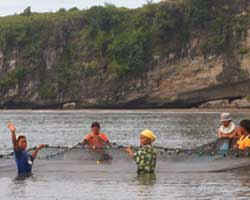
(Source: http://www.motherjones.com/news/feature/2007/09/rick-ness-mr-clean.html
)
Indonesian Corruption
The Economist and Wall Street Journal admit that NEM exploited for a while Indonesia's
reputation for corruption and that it may have paid off a number of government officials.
But this
is
merely the
way business is done there. They point to the fact that an Indonesian
Court
has
dismissed charges of pollution against NEM, leaving the matter up to an Arbitration Court.
But
this leaves unanswered the question of whether this Court was itself bribed.
Here
is another link suggesting bribery may have played a role in he Court's decision.
A
Wall Street Journal article written by a 21-year old intern who had never been to
Indonesia then
claimed the charges were groundless. The local problems were of long standing and
exaggerated by
extortionists and politicians who wanted to nationalize the mines.
"Mother Jones found that "the waste on Buyat's seafloor had
arsenic concentrations 16 times higher, and
mercury levels 8 times higher, than those at which adverse environmental effects are
frequently expected"
The
2004 study by the Indonesian government found that wells in Buyat Village had
"arsenic concentrations up
to
six times the Indonesian drinking water standard" and that "tests Newmont
conducted before opening the
mine
found no arsenic." And 17 tons of mercury released into the air can't be good for the
environment:
"That's like having 15 to 20 coal-fired power plants in your back yard."
( http://www.motherjones.com/mojoblog/archives/2007/12/6613_newmont_cleared.html
)
"SELL or LEAVE"
On February 12, 2008, the Indonesian
government has threatened to terminate Newmont Mining Corp.'s
30-year
contract to run a huge copper and gold mine on Sumbawa Island because NEM has not stuck to
a timetable
to divest itself of a 51% stake to local authorities. See also
( http://www.forbes.com/2008/02/12/newmont-mining-indonesia-markets-equity-cx_vk_0212markets03.html?partner=yahootix
)
PERU 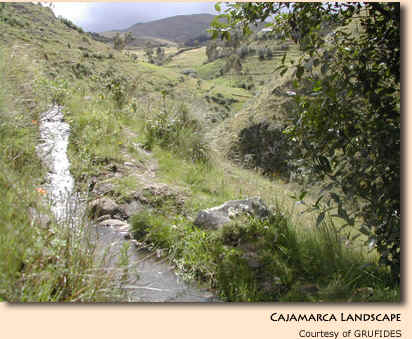
. The World's Largest Mercury Spill
"In 2000, campesinos were directly confronted with the dangers of living with toxic
chemicals, when
they endured what has
been labeled the world’s largest mercury spill. A (Newmont) truck that was hauling
away canisters of
mercury, a byproduct of cyanide gold mining, spilled 330 pounds of the poisonous metal
on a road running
through the towns of Choropampa, Magdalena and San Juan, 53 miles from the mine.
Thinking the mercury
contained gold, thousands of villagers took pieces of it home, some cooking it on their
stoves. The result was
mercury poisoning: impaired hearing and vision, central nervous system disorders, birth
defects, miscarriages,
and liver and kidney damage. The Peruvian government fined Yanacocha $500,000 for
an incident it
initially tried to downplay. The mine eventually offered to pay some restitution if the
townspeople
would sign documents
clearing the mining company of further responsibility. But more than 1,100 residents
decided instead to file
a class action lawsuit against Newmont. The suit is still pending."
Newmont
Bribery in Peru
"This was not the first high profile legal dispute Newmont faced. Yanacocha was
initially founded by a
partnership of
the American company Newmont, the Peruvian company Buenaventura, and a French
government-owned
company, Bureau de Recherches Géologiques et Minières (BRGM). These partners
were later joined
by the World Bank. Conflict arose when BRGM decided to sell most of its share to Normandy
Poseidon, an
Australian company. Newmont filed suit in Peruvian court, claiming that BRGM could not
sell to
a new company
without first offering its shares to the original stakeholders. The lower courts ruled in
favor of
Newmont, but the
Peruvian Supreme Court agreed to review the decision. Peruvian courts were notoriously
corrupt at the
time and Newmont suspected that the French government had intervened in an attempt to get
a
favorable ruling.
Newmont representative Larry Kurlander went to talk with a high-level Peruvian official
who
had a reputation
for bribery, and their
conversation was captured on videotape as part of a larger corruption
scandal that
brought down the government of former Peruvian President Alberto Fujimori. While Newmont
denies any
illegal influence, the Supreme Court eventually voted to allow Newmont to buy out BRGM at
a
bargain price in
1998. Now, Newmont owns the majority of the mine, with smaller shares controlled by
Buenaventura and
the World Bank. Neither the United States Foreign Corrupt Practices Act, which forbids
American
companies from bribing officials of foreign governments, nor the World Bank’s unit on
fraud and
corruption has
been brought to bear on this case."
(Source: http://www.sacredland.org/world_sites_pages/MtQuilish.html
)
In Peru, the Denver Post review (mentioned below) found of NEM's
mine's sediment controls
were vastly
inadequate and that the mine repeatedly poured sediment laced with heavy metals and other
contaminants into
streams. The mine's cyanide treatment facilities, including a treatment plant and holding
ponds,
were too small
and sometimes released more cyanide than permitted into waterways, the internal review
said. The
urgency of the
problem was highlighted by the company's insurer, which around the same time found that a
sustained storm
might lead to a significant cyanide spill at the mine.
 |
Tiger
Software
Research on Individual Stocks upon Request: Composite Seasonality Graph
|
Widespread Environmental Degradation and Health Hazards
Continued....
| NEWMONT'S CYANIDE MINING HAZARDS IMPERIL NEVADA Consider the Denver Post's investigation. In Lone Tree, Nevada, giant drills pierce holes in rock that will be crumbled by explosives. Massive shovels load earth onto dump trucks, which carry it to a mound where sprinklers will spray it with millions of gallons of cyanide and water. From each 200-ton load of rock and ore, Denver-based Newmont, the world's largest gold producer, will extract an average of about $3,000 worth of gold. Just enough to make a dozen wedding rings! Former employees complained that Newmont concealed, understated or ignored the very environmental concerns that were raised within the company. It even retaliated against very people who pointed out the dangers its mining operations were creating. Among the Post's findings, in Nevada, Newmont violated water-quality standards at the Lone Tree mine for at least four years, releasing greater- than-permitted quantities of contaminants such as arsenic and boron, according to the mine's own monitoring reports. Ainsworth and another employee say they were fired after they took environmental problems at the mine to their bosses. Later, Newmont temporarily blocked a state investigation into the issue....These employees raised public concerns about the dumping of contaminants into Nevada waterways...Newmont's internal review highlighted these problems for senior company managers. But the problem wasn't fixed until after it became public.
|
|
THE HIGH ENVIRONMENTAL COST OF GOLD MINING ELSEWHERE Venezuela Gold miners in Venezuela are wreaking havoc on the Amazon rain forest, and its inhabitants, because of their destructive mining techniques. These miners are the same ones who were expelled for damaging the Amazon and the Yanomami Indian reservations in the Brazilian state of Roraima in 1990. The central government has been debating methods of enforcing tougher border controls, as well as tougher statutes on the export of gold from Venezuela, however, at present, the state is powerless to intervene... As most of Venezuela's proven gold reserves lie near the surface, its extraction is easy and profitable for large scale mining operations. These garimpeiros utilize high power water cannons, connected to nearby rivers, to blast away vast amounts of soil and vegetation. As the soil in the Amazon rain forest is of poor quality, and fragile, the deforestation caused by the miners is, in essence, irreversible. The removed soil is carried away, leaving open pits which are filled with water. The resulting mud holes are a breeding ground for malaria-carrying mosquitoes. Also, the soil which is removed causes increased sedimentary silt build ups which clog the turbines at the Guri Dam on the Caroni River, the nation's main source of hydroelectric power. This has caused the abandonment of plans to further expand the facility. In addition, mercury has been extensively utilized as it aids in the gold amalgamation process. This mercury has turned up in unsafe quantities in the livers of widely-consumed fish, as well as at popular beaches and in the water taps of local residents. http://american.edu/TED/VENGOLD.HTM |
| Guyana International Human Rights Clinic (IHRC) of Harvard Law School’s Human Rights Program: A report, titled “All that Glitters: Gold Mining in Guyana,” notes that the Guyanese government has failed to reign in wildcat miners and protect the rights of indigenous populations. It also says the mining has caused deforestation and mercury pollution, which can cause severe public health problems, and worsened malaria in the region. “Our observations confirmed that the areas around mines resemble a moonscape of barren, mounded sand and mud,” Docherty said. “Since small scale miners typically wash the topsoil away in order to get to the gold-bearing clayey soil underneath, the sites of former mines are quite infertile and incapable of supporting regenerated rainforest.” |
El Salvador - underground mine
|
 ...
... Gold mining may be employed
on a larger scale by constructing a short sluice box, with barriers along the bottom to trap the heavier gold
particles as water washes them and the other material along the box. This method better
suits excavation with shovels
or similar implements to feed ore into the device. Similar in principle to a sluice is a rocker,
a cradle-like piece of equipment that could be rocked like a cradle to sift sands through
screens, which was introduced by Chinese miners in British Columbia and Australia, where
the practice was referred to as "rocking the golden baby". . Another Chinese
technique was the use of blankets to filter sand and gravels, catching fine gold in the
fabric's weave, then burning the blankets to smelt the gold. Chinese were noted for the
thoroughness of their placer extraction techniques, which included hand-washing of
individual rocks as well as the complete displacement of streambeds and advanced flume and
ditching techniques which became copied by other miners.
Gold mining may be employed
on a larger scale by constructing a short sluice box, with barriers along the bottom to trap the heavier gold
particles as water washes them and the other material along the box. This method better
suits excavation with shovels
or similar implements to feed ore into the device. Similar in principle to a sluice is a rocker,
a cradle-like piece of equipment that could be rocked like a cradle to sift sands through
screens, which was introduced by Chinese miners in British Columbia and Australia, where
the practice was referred to as "rocking the golden baby". . Another Chinese
technique was the use of blankets to filter sand and gravels, catching fine gold in the
fabric's weave, then burning the blankets to smelt the gold. Chinese were noted for the
thoroughness of their placer extraction techniques, which included hand-washing of
individual rocks as well as the complete displacement of streambeds and advanced flume and
ditching techniques which became copied by other miners.
Using a sluice box to extract gold from placer deposits has been a common practice in prospecting and small-scale mining throughout history to the modern day. A sluice box is essentially a man-made channel with riffles set in the bottom. The riffles are designed to create dead zones in the current to allow gold to drop out of suspension. The box is placed in the stream to catch water-flow and gold bearing material is placed at the top of the box. The material is carried by water through the box where gold and other heavy material settles out behind the riffles. Lighter material flows out of the box as tailings.
A trammel is composed of a slightly-inclined rotating metal tube (the 'scrubber section') with a screen at its discharge end. Lifter bars, sometimes in the form of bolted in angle iron, are attached to the interior of the scrubber section. The ore is fed into the elevated end of the trammel. Water (often under pressure) is provided to the scrubber and screen sections and the combination of water and mechanical action frees the valuable minerals from the ore. The mineral containing ore that passes through the screen is then further concentrated in smaller devices such as sluices and jigs. The larger pieces of ore that do not pass through the screen can be carried to a waste stack by a conveyer.
Hydraulic mining
Hydraulic mining is a type of placer mining used in areas where large amounts of loose gravel and sand or soil are poorly packed and may be washed away with a heavy stream of water. Fire hoses (Water cannons) are sometimes used to strip away entire hills of loose gravel, which are then run through a sluice (a wooden trough with riffles). Gold, being heavier, does not move as easily as other material in the sluice. This technique can damage the environment, causing mud in streams below the mining site and erosion damage at the site itself.
In earlier times the process water was not generally recycled and the spent ore was not reclaimed. Environmental activists describe the hydraulic mining form of placer mining as environmentally destructive because of the large amounts of silt that it adds to previously clear running streams. Most placer mines today use settling ponds, if only to ensure that they have sufficient water to run their sluicing operations.
In California, from 1853 to 1884, "hydraulicking" of placers removed an enormous amount of material from the gold fields, material that was carried downstream and raised the level of the Central Valley by some seven feet in some areas and settled in a huge layer at the bottom of San Francisco Bay. The process raised an opposition calling themselves the "Anti-Debris Association". In January of 1884, a United States District Court banned the flushing of debris into streams, and the hydraulic mining mania in California's gold country came to an end.
Hard rock mining
Hard rock gold mining is done when the gold is encased in rock, rather than as
particles in loose sediment. Sometimes open-pit
mining is used, such as the Ft. Knox Mine in central Alaska. Barrick Gold Corporation has one of the largest
open-pit gold mines in North America, located on its Goldstrike property in northeastern Nevada. Other gold mines use
underground mining, where the ore is extracted through tunnels or shafts. Hard rock mining
produces most of the world's gold. In placer mines, the gold is recovered by gravity
separation. For hardrock mining, other methods are usually used.
Cyanide process
Cyanide extraction of gold may be used in areas where fine-gold bearing rocks are found. Sodium cyanide solution is mixed with finely-ground rock that is proven to contain gold and/or silver, and is then separated from the ground rock as gold cyanide and/or silver cyanide solution. Zinc is added to the solution, precipitating out residual zinc, as well as the desirable silver and gold metals. The zinc is removed with sulphuric acid, leaving a silver and/or gold sludge that is generally smelted into an ingot that is shipped to a metals refinery for final processing into 99.9999% pure metals.
Advancements in the 1970s have seen activated carbon used in extracting gold from the leach solution. The gold is absorbed into the porous matrix of the carbon. Activated carbon has so much internal surface area[1], that fifteen grams (half an ounce) has the equivalent surface area of the Melbourne Cricket Ground (18,100 square meters). The gold can be removed from the carbon by using a strong solution of caustic soda and cyanide. This is known as elution. Gold is then plated out onto steel wool through electrowinning. Gold specific resins can also be used in place of activated carbon, or where selective separation of gold from copper or other dissolved metals is required.
The cyanide technique is very simple and straightforward to apply and a popular method for low-grade gold and silver ore processing. Like most industrial chemical processes, there are potential environmental hazards presented with this extraction method in addition to the high toxicity presented by the cyanide itself. This was seen in the environmental disaster in Central-Eastern Europe in year 2000, when during the night of 30 January, a dam at a goldmine reprocessing facility in Romania released approximately 100,000 m³ of wastewater contaminated with heavy metal sludge and up to 120 tonnes of cyanide into the rivers of Tisza.
